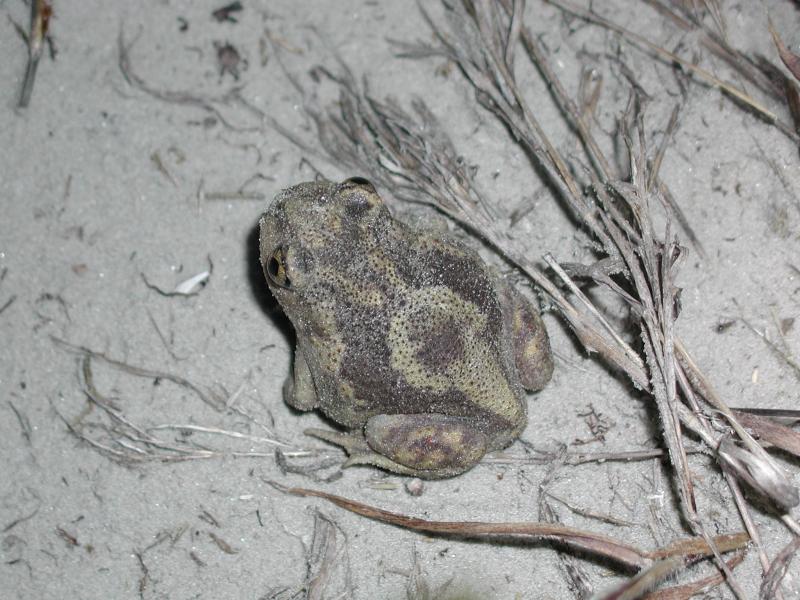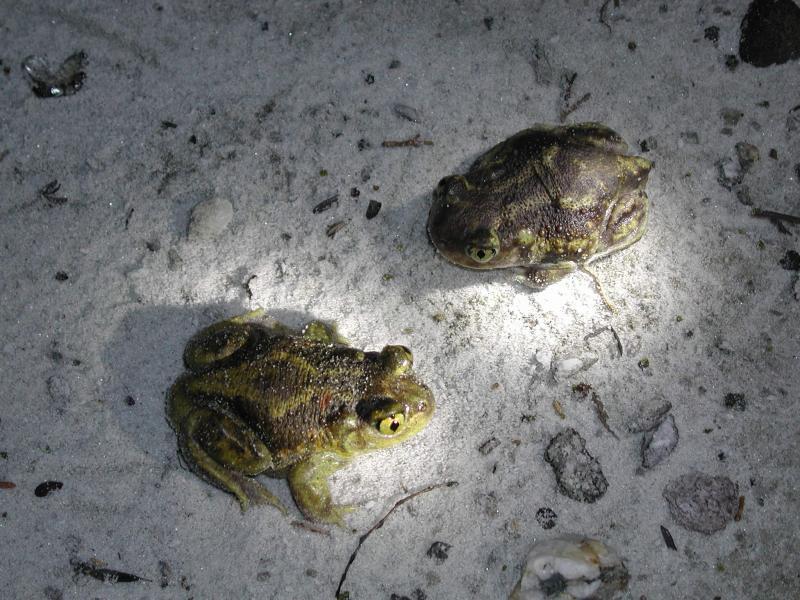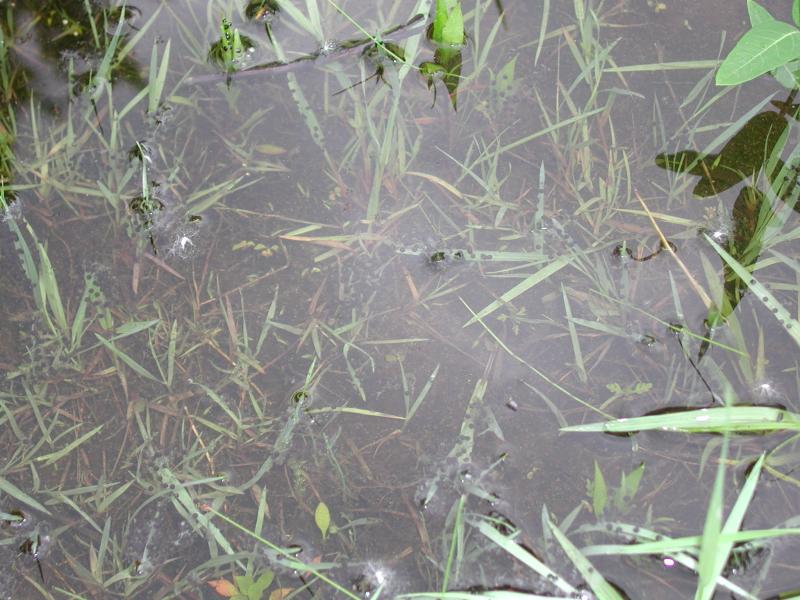Eastern Spadefoot
Scaphiopus holbrookii (Harlan, 1835)
- Class
- Amphibia (Amphibians)
- Family
- Scaphiopodidae (North American Spadefoots)
- State Protection
- Special Concern
Listed as Special Concern by New York State: at risk of becoming Threatened; not listed as Endangered or Threatened, but concern exists for its continued welfare in New York; NYS DEC may promulgate regulations as to the taking, importation, transportation, or possession as it deems necessary.
- Federal Protection
- Not Listed
- State Conservation Status Rank
- S2S3
Imperiled or Vulnerable in New York - Very vulnerable, or vulnerable, to disappearing from New York, due to rarity or other factors; typically 6 to 80 populations or locations in New York, few individuals, restricted range, few remaining acres (or miles of stream), and/or recent and widespread declines. More information is needed to assign either S2 or S3.
- Global Conservation Status Rank
- G5
Secure globally - Common in the world; widespread and abundant (but may be rare in some parts of its range).
Summary
Did you know?
Some people suffer from strong allergic reactions when handling spadefoots. The reaction may include watery eyes, a runny nose, and violent sneezing (Conant and Collins 1998).
State Ranking Justification
Despite intensive survey efforts during the New York State Department of Environmental Conservation Amphibian and Reptile Atlas project, occurrences were reported from only 13 USGS topographic quadrangles between 1990 and 1999. Two additional occurrences were subsequently located in Dutchess and Saratoga Counties. A historical population in Rockland County (DeKay 1842) is apparently extirpated. This species appears to be fairly localized where it occurs.
Short-term Trends
Habitat loss to development, especially of vernal pool habitats, is likely resulting in a negative short-term trend (New York State Department of Environmental Conservation 2006).
Long-term Trends
Long-term trends are unknown, due to the absence of reliable baseline information (New York State Department of Environmental Conservation 2006). At least one historical population reported from Clarkstown, Rockland County, (DeKay 1842) is believed to be extirpated.
Conservation and Management
Threats
Threats include vernal pond loss from development, upland habitat loss and fragmentation, road mortality, contaminants, parasites, and pathogens (New York State Department of Environmental Conservation 2006).
Conservation Strategies and Management Practices
The development of an eastern spadefoot management plan would be beneficial (New York State Department of Environmental Conservation 2006).
Habitat
Habitat
Eastern spadefoot habitat is characterized by dry sandy soils or loose soils. Spadefoots are found in pine barrens and associated habitats in Saratoga and Albany Counties and in pitch pine-scrub oak dunes on Long Island. The Dutchess County location contains limestone bedrock outcroppings, which are highly erodable and form limestone sand deposits in the surrounding area. The forest in this area is predominately red cedar.
Associated Ecological Communities
- Pine barrens vernal pond
(guide)
A seasonally fluctuating pond and its associated wetlands that typically occurs in pine barrens. The water is intermittent, usually a pond in the spring but sometimes losing water through the summer to become a mostly vegetated wetland at the end of the summer. These ponds and wetlands may be small.
- Pitch pine-scrub oak barrens
(guide)
A shrub-savanna community that occurs on well-drained, sandy soils that have developed on sand dunes, glacial till, and outwash plains.
- Red cedar rocky summit
(guide)
A community that occurs on warm, dry, rocky ridgetops and summits where the bedrock is calcareous (such as limestone or dolomite, but also marble, amphibolite, and calcsilicate rock), and the soils are more or less calcareous. The vegetation may be sparse or patchy, with numerous lichen covered rock outcrops.
Associated Species
- American Toad (Anaxyrus americanus)
- Fowler's Toad (Anaxyrus fowleri)
- Gray Treefrog (Hyla versicolor)
- Spring Peeper (Pseudacris crucifer)
Range
New York State Distribution
This species is primarily found on Long Island (Nassau and Suffolk Counties), with isolated populations in Dutchess, Albany, and Saratoga Counties.
Global Distribution
This is the only spadefoot species found east of the Mississippi River, and it is found from southern New England across the southern Great Lakes states to southeastern Missouri, south to the Gulf Coast, and from eastern Louisiana to southern Florida (Conant and Collins 1991; Conant and Collins 1998). It is absent from many upland areas, including the higher elevations in the Appalachians (Conant and Collins 1991; Conant and Collins 1998).
Best Places to See
- Albany Pine Bush Preserve
Identification Comments
Identifying Characteristics
The eastern spadefoot is a medium-sized toad with smooth skin and small, scattered warts. Distinguishing characteristics include protruding golden eyes with vertical pupils, two golden dorsal stripes that are in the shape of a lyre, and a sharp-edged, sickle-shaped "spade" on the underside of each hind foot (Klemens 1993; Conant and Collins 1998; Gibbs et al. 2007). The tadpoles are bronze and have a short, rounded, and finely spotted tail (Wright and Wright 1949; Gibbs et al. 2007). The golden dorsal pattern mentioned above is also evident on the tadpoles. The call of breeding males has been described as a coarse "wank, wank, wank..." (Gibbs et al. 2007).
Characters Most Useful for Identification
The characters most useful for identification include the protruding golden eyes with vertical pupils, two golden dorsal stripes that form the shape of a lyre, and a sharp-edged, sickle-shaped "spade" on the underside of each hind foot (Klemens 1993; Conant and Collins 1998; Gibbs et al. 2007).
Best Life Stage for Proper Identification
Adults are most easily identified, although newly metamorphosed individuals have a similar appearance to adults and can also be distinguished as spadefoots.
Behavior
Eastern spadefoots are fossorial; that is, they are adapted to digging and can remain underground for weeks or months at a time during dry periods. Adults are nocturnal, with peaks of activity just after sundown and before sunrise (DeGraaf and Rudis 1981), especially after warm wet periods in the spring and the summer. Breeding aggregations usually occur after heavy rains, often in spring or summer in the north, but they have been recorded in February (small numbers), March, June, September, and October in Florida (Greenberg and Tanner 2004). These breeding aggregations may include dozens to hundreds of adults in single pools, where clutches of up to 2,500 eggs are laid in several batches. The eggs hatch in two days to two weeks. The aquatic larvae metamorphose into the terrestrial form in two to eight weeks (Greenberg and Tanner 2004). In Florida, the maximum lifespan was estimated to be seven years (Greenberg and Tanner 2005). Adults may migrate up to several hundred meters between breeding pools and nonbreeding terrestrial habitats.
Diet
Metamorphosed toads eat various small terrestrial invertebrates. Larvae eat plankton initially, and later feed on small aquatic invertebrates and sometimes other amphibian larvae, including conspecifics.
Best Time to See
Although early and late sight records on Long Island range from early to late April and early September (Burnley 1971), respectively, the best time to see eastern spadefoot toads is at night during or after heavy rains that coincide with the breeding season.
- Present
- Active
- Reproducing
The time of year you would expect to find Eastern Spadefoot present, active, and reproducing in New York.
Similar Species
- American Toad (Anaxyrus americanus)
In contrast to the eastern spadefoot, American toads have two tubercles on the underside of each hind foot, instead of the single "spade" of the spadefoot. They have one to two well-developed warts within each of the largest dark spots and do not have the lyre-shaped dorsal pattern. American toads also have ridges and parotid glands, which are lacking in eastern spadefoots. The pupils are horizontally oval (Conant and Collins 1998).
- Fowler's Toad (Anaxyrus fowleri)
In contrast to the eastern spadefoot, Fowler's toads have two tubercles on the underside of each hind foot, instead of the single "spade" of the spadefoot. They have three or more well-developed warts within each of the largest dark spots and do not have the lyre-shaped dorsal pattern. Fowler's toads also have ridges and parotid glands, which are lacking in eastern spadefoots. The pupils are horizontally oval (Conant and Collins 1998).
Eastern Spadefoot Images
Taxonomy
Eastern Spadefoot
Scaphiopus holbrookii (Harlan, 1835)
- Kingdom Animalia
- Phylum Craniata
- Class Amphibia
(Amphibians)
- Order Anura
(Frogs and Toads)
- Family Scaphiopodidae (North American Spadefoots)
- Order Anura
(Frogs and Toads)
- Class Amphibia
(Amphibians)
- Phylum Craniata
Additional Resources
References
Barbour, R. W. 1971. Amphibians and reptiles of Kentucky. Univ. Press of Kentucky, Lexington. x + 334 pp.
Behler, J. L., and F. W. King. 1979. The Audubon Society field guide to North American reptiles and amphibians. Alfred A. Knopf, New York. 719 pp.
Bragg, A.N. 1965. Gnomes of the night. the spadefoot toads. 127 pp.
Burnley, J.M. 1971. Early date records of amphibians and reptiles on Long Island. Engelhardtia 4(1):1-7.
Burnley, J.M. 1971. Late date records of amphibians and reptiles on Long Island. Engelhardtia 4(3):17-22.
Burnley, J.M. 1973. Eastern spadefoots, Scaphiophus holbrooki, found on the South Fork of Long Island during 1973. Engelhardtia 6(1):10-11.
Collins, J. T. 1991. Viewpoint: a new taxonomic arrangement for some North American amphibians and reptiles. SSAR Herpetol. Review 22:42-43.
Conant, R. and J. T. Collins. 1991. A field guide to reptiles and amphibians: eastern and central North America. Third edition. Houghton Mifflin Co., Boston, Massachusetts. 450 pp.
Conant, R., and J. T. Collins. 1998. A field guide to reptiles and amphibians: eastern and central North America. Third edition, expanded. Houghton Mifflin Co., Boston, Massachusetts. 616 pp.
DeGraaf, R. M., and D. D. Rudis. 1983a. Amphibians and reptiles of New England. Habitats and natural history. Univ. Massachusetts Press. vii + 83 pp.
DeGraaf, R.M. and D.D. Rudis. 1981. Forest habitat for reptiles and amphibians of the northeast. United States Department of Agriculture, Forest Service Eastern Region, Milwaukee, WI. 239 pp.
DeKay, J.E. 1842. Zoology of New-York or the New-York fauna comprising detailed descriptions of all of the animals hitherto observed within the state of New-York, with brief notices of those occassionally found near its borders, and accompanied by appropriate illustrations. Part III Reptiles and Amphibia. Albany: W. and A. White and J. Visscher.
Gibbs, J.P., A.R. Breisch, P.K. Ducey, G. Johnson, J.L. Behler, and R.C. Bothner. 2007. The amphibians and reptiles of New York State. Oxford University Press, NY.
Green, N. B., and T. K. Pauley. 1987. Amphibians and reptiles in West Virginia. University of Pittsburgh Press, Pittsburgh, Pennsylvania. xi + 241 pp.
Greenberg, C. H., and G. W. Tanner. 2004. Breeding pond selection and movement patterns by eastern spadefoot toads (Scaphiopus holbrookii) in relation to weather and edaphic conditions. Journal of Herpetology 38:569-577.
Greenberg, C. H., and G. W. Tanner. 2005. Spatial and temproal ecology of easterb spadefoot toads on a Florida landscape. Herpetologica 61:20-28.
Johnson, T.R. 1977. The Amphibians of Missouri. University of Kansas Museum of Natural History, Public Education Series 6: ix + 134 pp.
Klemens, M.W. 1993. Amphibians and Reptiles of Connecticut and Adjacent Regions. State Geological and Natural History Survey of Connecticut, Bulletin No. 112.
Mathewson, R.F. 1955. Reptiles and amphibians of Staten Island. Proceedings of the Staten Island Institute of Arts and Sciences. 17(2):28-50.
Minton, S. A., Jr. 1972. Amphibians and reptiles of Indiana. Indiana Academy Science Monographs 3. v + 346 pp.
Mount, R. H. 1975. The reptiles and amphibians of Alabama. Auburn University Agricultural Experiment Station, Auburn, Alabama. vii + 347 pp.
New York Natural Heritage Program. 2024. New York Natural Heritage Program Databases. Albany, NY.
New York State Department of Environmental Conservation, Division of Fish, Wildlife, and Marine Resources. 2006. New York State Comprehensive Wildlife Conservation Strategy. Albany, NY: New York State Department of Environmental Conservation.
Wasserman. A. O. 1968. Scaphiopus holbrookii. Cat. Am. Amph. Rep. 70.1-70.4.
Links
About This Guide
Information for this guide was last updated on: November 8, 2007
Please cite this page as:
New York Natural Heritage Program. 2024.
Online Conservation Guide for
Scaphiopus holbrookii.
Available from: https://guides.nynhp.org/eastern-spadefoot/.
Accessed July 27, 2024.


